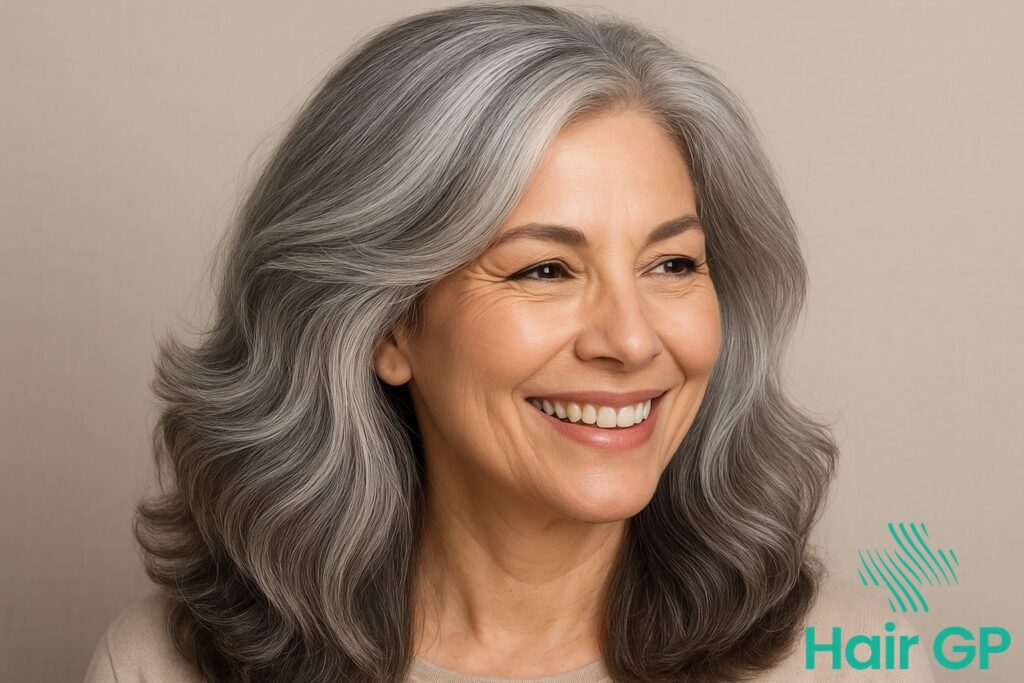Introduction
The journey of aging hair presents a unique double challenge: as natural pigment fades to reveal grey strands, hair follicles simultaneously begin to miniaturize, resulting in thinner, more delicate hair strands. This combination creates a complex scenario where traditional hair color approaches may prove too harsh for increasingly fragile aging hair, making effective grey hair coverage while maintaining healthy hair a delicate balancing act.
Understanding how to navigate hair color choices for thin hair requires a specialized approach that prioritizes strand integrity above all else. Unlike younger, thicker hair that can withstand aggressive chemical processing, aging hair demands gentler techniques that work with, rather than against, its changing structure and reduced resilience.
This comprehensive guide explores the science behind these dual changes, helping you understand why your hair strands behave differently as they age. We’ll examine gentle coloring methods specifically designed for fragile grey hair, compare professional salon treatments with at-home alternatives, and detail essential preparation steps that maximize protection during the coloring process.
Additionally, we’ll cover crucial aftercare routines that maintain both color vibrancy and hair health, explore smart maintenance strategies that minimize cumulative damage, and share styling techniques that enhance your colored results. Finally, we’ll identify common mistakes that can compromise aging hair, providing you with the knowledge to make informed decisions that preserve your hair’s integrity while achieving the coverage and color results you desire.
Key Takeaways – TL/DR
- Thinning grey hair requires gentler coloring techniques than traditional hair dye methods
- Semi-permanent and demi-permanent colors cause less damage than permanent dye formulations
- Professional consultation is crucial for assessing hair condition before any color treatment
- Proper pre and post-color conditioning can significantly reduce breakage and strand damage
The Science Behind Grey and Thinning Hair Changes
The simultaneous occurrence of greying and thinning represents complex biological changes that fundamentally alter how aging hair responds to color treatments. Understanding these underlying processes enables more informed decisions about hair coloring approaches that preserve hair health while achieving desired coverage results.
Melanin Production and Grey Hair Development
When hair turn gray, melanocyte cells within hair follicles gradually reduce melanin production by approximately 10-20% per decade after age 30 [1]. This declining pigment synthesis creates structural changes beyond simple color loss. Grey hair strands typically develop a coarser, more porous texture compared to pigmented hair, affecting how color molecules penetrate and adhere to the hair shaft. The altered cuticle structure in grey hair allows for faster color absorption but also leads to more rapid color fading. Additionally, premature hair graying can accelerate these textural changes, making some individuals experience color challenges earlier than expected. These modifications in hair structure require adjusted processing times and formulation choices to achieve even color distribution without over-processing.
Hair Thinning and Strand Fragility
Concurrent with greying, aging hair experiences follicle miniaturization, where hair growth cycles progressively produce thinner strands. Research indicates that hair diameter can decrease by up to 50% between ages 20 and 80 [2]. This reduction in strand thickness creates increased fragility, making aging hair more susceptible to damage from chemical processing. Miniaturized follicles also produce hair strands with altered protein structures, affecting their ability to withstand traditional coloring chemicals. The combination of reduced strand diameter and modified protein composition means that aging hair requires gentler formulations and modified application techniques. Understanding these biological changes helps explain why mature hair often needs specialized color products designed for fragile, thinning hair rather than standard formulations created for stronger, younger hair strands.
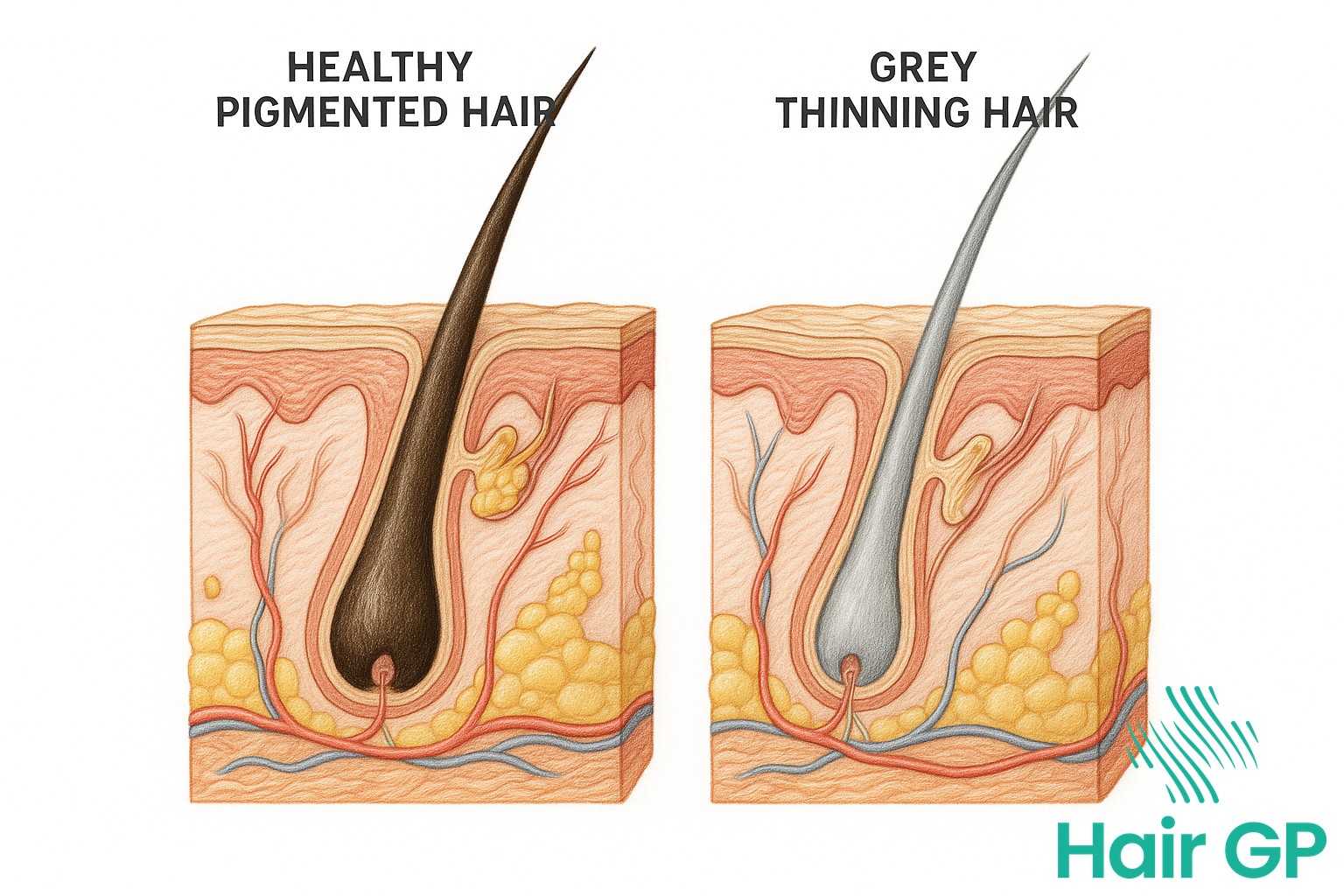
Gentle Coloring Techniques for Fragile Grey Hair
Achieving effective grey hair coverage while preserving hair integrity requires specialized techniques that prioritize gentleness over speed. Modern coloring approaches focus on gradual color building and damage-minimizing formulations that work harmoniously with aging hair’s delicate structure.
Semi-Permanent vs Permanent Color Options
The choice between semi-permanent and permanent color significantly impacts hair health during grey hair coverage. Demi permanent formulations offer an ideal middle ground, containing no ammonia and using lower volumes of developer, making them substantially gentler than traditional permanent color options. These deposit-only colors work by adding pigment without lifting the hair’s natural color, resulting in less structural damage to already fragile strands.
Semi-permanent hair dye provides the gentlest approach, lasting 4-6 weeks while gradually fading without harsh demarcation lines. This gradual fading benefit allows for color adjustments and reduces the stark regrowth appearance common with permanent color. For those seeking longer-lasting results, demi permanent options extend wear to 6-8 weeks while maintaining significantly lower damage levels than traditional permanent formulations.
Ammonia-free formulas represent a crucial advancement in gentle hair color technology. These formulations replace harsh alkalis with gentler alternatives like ethanolamine, which opens the hair cuticle more gradually and causes less protein loss. The result is dyed hair that maintains better moisture retention and structural integrity throughout the coloring process.
Sectioning and Application Strategies
Professional sectioning techniques ensure even grey hair coverage while preventing over-processing vulnerable areas. Strategic sectioning involves dividing hair into quarter-inch sections, starting application at areas with the most resistant grey coverage and working systematically through less porous sections. This methodical approach prevents color overlap and ensures consistent results.
Timing considerations prove critical when working with fragile hair. Processing times should be reduced by 20-30% compared to virgin hair, with careful monitoring every 5-10 minutes to assess color development. Overlapping prevention becomes essential during touch-up applications, using foils or protective barriers to shield previously colored sections from repeated chemical exposure.
Temperature control during application further minimizes damage, as heat accelerates chemical reactions and can cause excessive processing. Room temperature application with gentle manipulation helps preserve hair’s structural integrity while achieving desired color results.
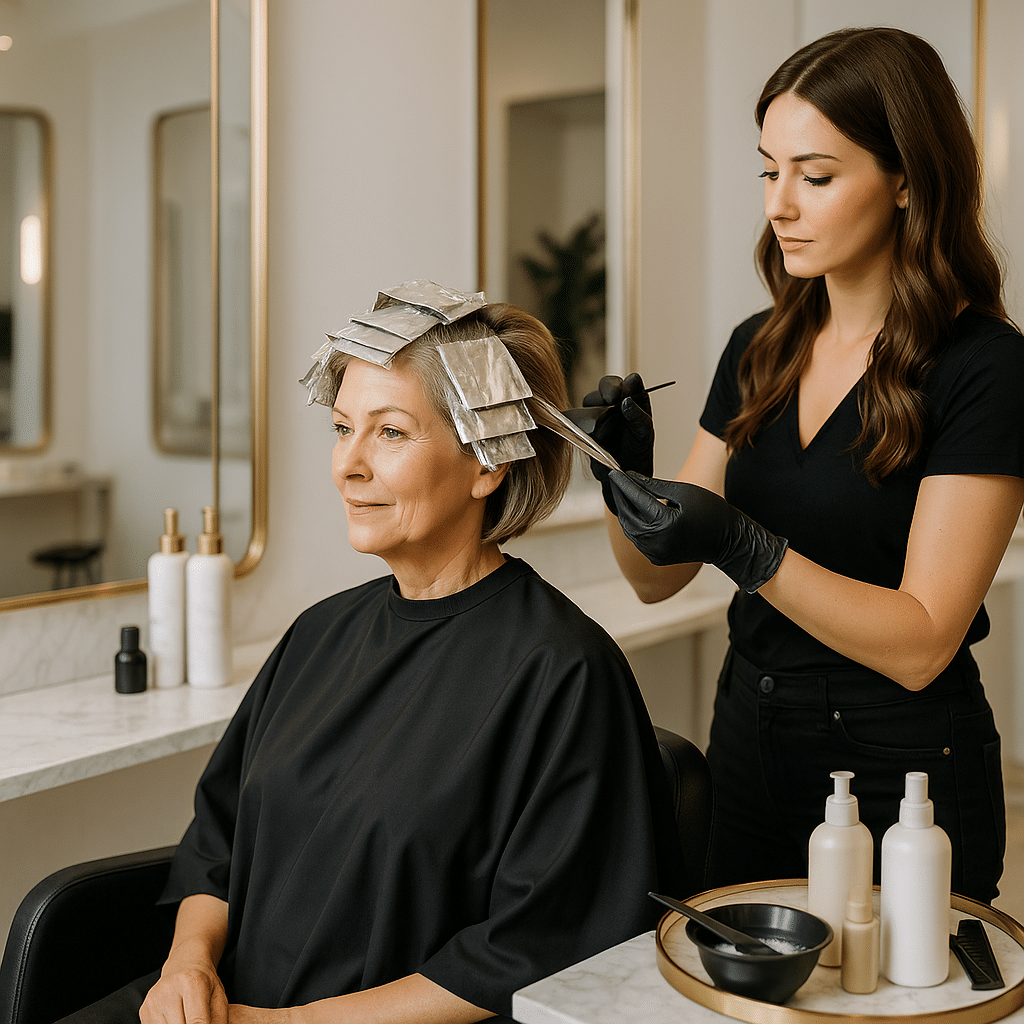
Professional vs At-Home Coloring for Thinning Hair
Choosing between professional salon services and at-home coloring for grey thinning hair requires careful consideration of your hair’s condition and coverage needs. The decision impacts both hair health and color results, making it essential to understand when professional expertise becomes necessary versus when gentle DIY approaches can effectively cover grey hair.
When to Choose Professional Services
A qualified hair stylist or hairdresser becomes essential when dealing with severe hair thinning or complex color challenges. Professional assessment helps determine if your scalp and remaining hair can withstand coloring processes safely. Experienced stylists can evaluate thinning patterns and recommend appropriate techniques that minimize further damage while achieving desired coverage.
Color correction situations particularly require salon expertise. If previous at-home attempts resulted in uneven coverage, brassy tones, or unexpected color outcomes, a hairstylist possesses the knowledge and professional-grade products needed to correct these issues safely. Attempting complex corrections at home often worsens the situation and can cause additional hair breakage.
Complex coverage requirements, such as blending multiple grey percentages or creating natural-looking highlights, benefit significantly from professional intervention. Salon colorists understand how to work with thinning hair’s altered texture and porosity, selecting appropriate formulations and application techniques that protect fragile strands while delivering comprehensive grey coverage.
Safe At-Home Options for Mild Cases
For individuals with mild thinning and limited grey coverage needs, gentle at-home options can provide effective results. Semi-permanent and demi-permanent formulas offer safer alternatives to permanent dyes, containing fewer harsh chemicals that could compromise already fragile hair. These products gradually fade over 4-8 weeks, allowing for color adjustments without permanent commitment.
Temporary solutions like color-depositing shampoos, root touch-up sprays, and tinted dry shampoos work well for minor grey coverage between salon visits. These products require no mixing or processing time, reducing potential damage while maintaining color consistency. Regular use helps build subtle color depth gradually.
Root concealer powders and temporary mascaras provide immediate coverage for emergency touch-ups. When selecting at-home products to cover grey hair, choose ammonia-free formulations specifically designed for sensitive or thinning hair. Always perform patch tests and follow instructions carefully, avoiding overlapping applications that could cause breakage or scalp irritation.

Pre-Color Preparation for Maximum Hair Protection
Proper preparation before hair coloring creates the foundation for healthy hair transformation while minimizing potential damage. Strategic pre-color treatments strengthen hair strands and establish optimal conditions for successful color application and long-term hair health.
Deep Conditioning Treatments
Hair structure requires reinforcement before chemical processing to prevent breakage and maintain integrity. Protein treatments work to fill microscopic gaps in damaged hair strands, particularly beneficial for dry hair that has experienced previous chemical processing or heat damage. A quality conditioner containing hydrolyzed proteins should be applied 3-5 days before coloring to allow adequate absorption without creating protein overload that could lead to brittleness.
Moisture balance proves equally crucial across all hair types, as dehydrated strands absorb color unevenly and are more susceptible to damage. Deep conditioning treatments restore essential moisture levels, creating a protective barrier that helps color penetrate evenly while maintaining strand flexibility. Natural hair particularly benefits from intensive moisture treatments, as its unique structure requires additional hydration support before chemical processing to prevent excessive dryness and breakage.
Treatment timing matters significantly – deep conditioning should occur 24-48 hours before coloring, allowing the hair cuticle to settle while maintaining enhanced strength and flexibility for optimal color reception.
Strand Testing and Consultation
Professional strand testing eliminates guesswork and prevents color disasters by revealing how specific hair types will respond to chosen formulations. This essential step involves applying color to a small, inconspicuous section to assess processing time, final color result, and hair tolerance levels across different hair strands.
Different hair types require varying processing times and developer strengths, making preliminary testing crucial for achieving desired results without compromising healthy hair integrity through proper damage assessment and customized approach selection. Patch tests are crucial to ensure you wont have an allergic reaction to the products.

Post-Color Care to Maintain Hair Health
Proper post-color care determines whether your newly dyed hair maintains its vibrancy or fades prematurely while becoming increasingly damaged. Strategic aftercare routines protect both color investment and hair health, extending the life of your colour transformation significantly.
Color-Safe Cleansing Routines
Gentle cleansing forms the foundation of effective color maintenance for dyed hair. Sulfate-free shampoo formulations prevent harsh stripping that causes rapid color fade and additional dryness. These gentler cleansers maintain the hair cuticle’s integrity while preserving color molecules within the hair shaft.
Washing frequency significantly impacts color longevity and overall hair health. Limit shampooing to 2-3 times weekly, allowing natural oils to nourish fragile strands between washes. Dry shampoo extends time between washes while maintaining cleanliness and volume.
Water temperature plays a crucial role in color preservation. Cool to lukewarm water prevents cuticle swelling that allows color molecules to escape. Hot water accelerates fading while increasing dryness in already compromised hair. Purple shampoo becomes essential for blonde or gray coverage, neutralizing unwanted yellow tones while maintaining desired color balance.
Weekly Maintenance Treatments
Regular maintenance treatments address both color vibrancy and structural hair health simultaneously. Color-depositing masks refresh fading tones while providing deep conditioning benefits. These treatments typically contain smaller color molecules that penetrate partially opened cuticles, reviving dulled colour between salon visits.
Protein treatments restore strength to chemically processed strands, preventing breakage that impedes healthy hair growth. Balance protein applications with moisturizing treatments to avoid over-strengthening, which can cause brittleness. Deep conditioning masks replenish moisture lost during the coloring process, maintaining flexibility and shine.
Alternating between protein and moisture treatments creates optimal conditions for color maintenance and continued hair growth. Schedule these treatments based on your hair’s specific needs, typically weekly for severely damaged hair or bi-weekly for moderately processed strands.
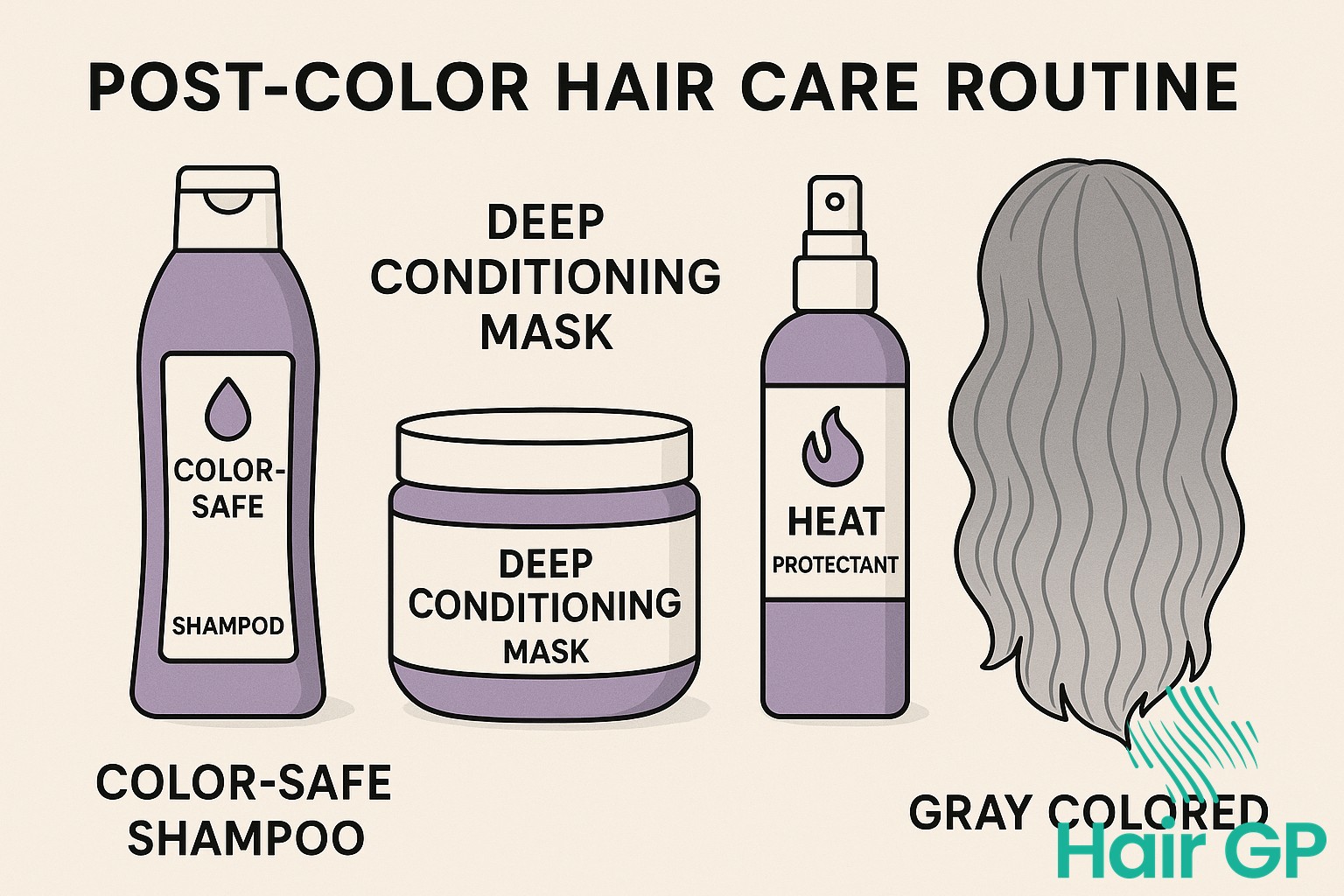
Color Maintenance Strategies for Longevity
Strategic colour maintenance extends vibrancy while protecting delicate hair structure during the gradual transition from natural colour to gray. Understanding how greys tend to emerge in patterns helps determine optimal maintenance approaches that work with your hair’s natural progression rather than against it.
Root regrowth management becomes particularly crucial when dealing with a few silver strands scattered throughout darker hair. Targeted touch-up techniques focus colour application only where needed, avoiding unnecessary processing of previously coloured sections. This selective approach prevents cumulative damage while maintaining seamless colour transitions as more grey grow in over time.
Color-safe products play a vital role in extending time between salon visits. Purple-toned shampoos neutralize brassiness in blonde tones, while color-depositing conditioners refresh vibrancy without harsh chemicals. These maintenance products work especially well for those going grey gradually, helping blend natural silver with colored sections for a more uniform appearance.
Timing considerations become essential as white hair increases in density. Monitoring regrowth patterns allows for strategic scheduling that maximizes color longevity while minimizing processing frequency. Professional colorists often recommend adjusting color formulations as the percentage of natural gray increases, creating more forgiving color choices that grow out gracefully.
Environmental protection strategies preserve color investment between appointments. UV protection sprays shield hair from sun damage that accelerates color fading, while heat protectants prevent thermal styling damage. Silk pillowcases reduce friction that can strip color from fragile strands. These protective measures work synergistically with professional color services to maintain vibrancy and hair health throughout the transition period, ensuring optimal results from each color application.
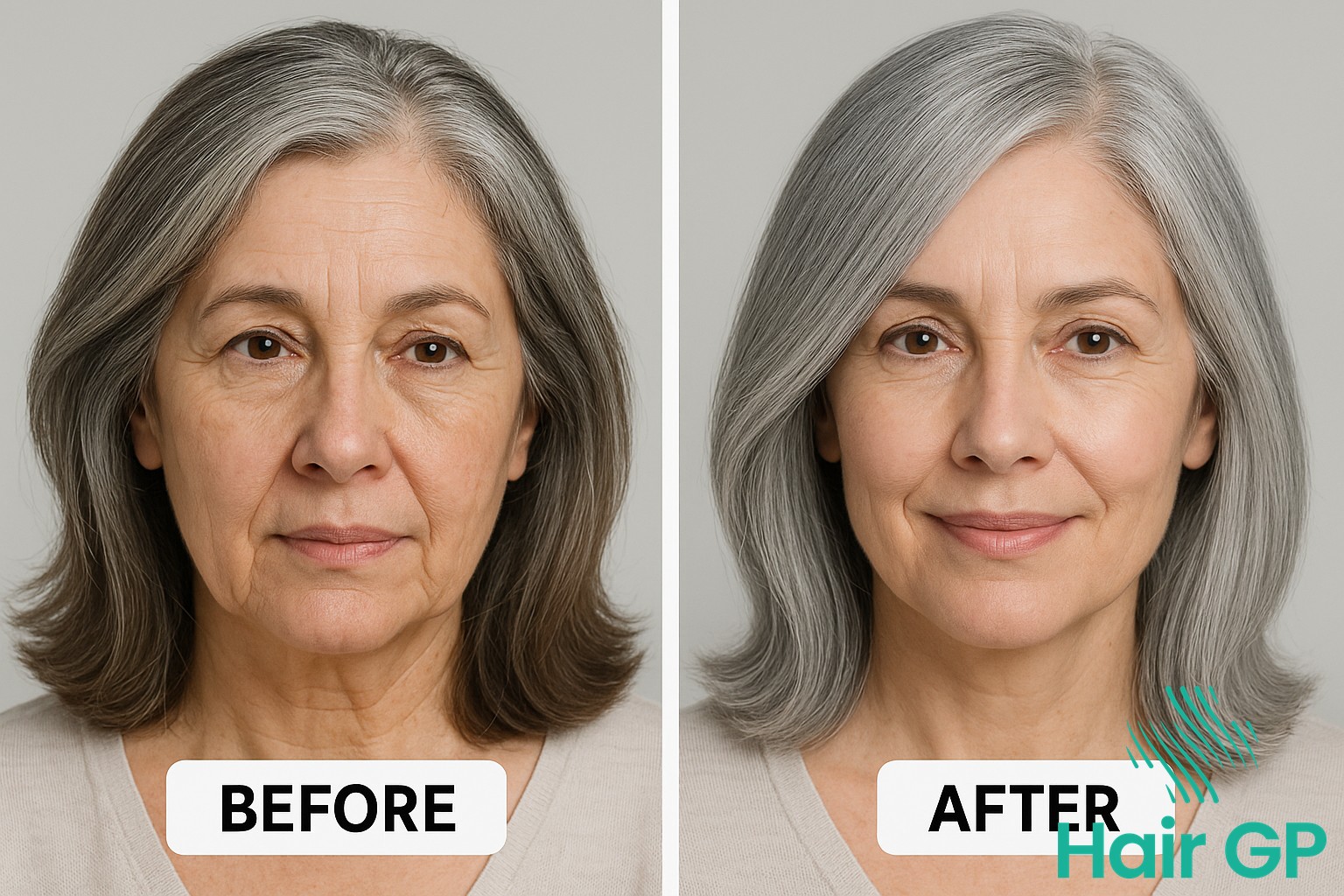
Styling Tips for Colored Grey and Thinning Hair
Styling colored grey and thinning hair requires a delicate balance between achieving your desired look and protecting fragile strands. Traditional heat styling can damage already compromised hair, causing frizz and further weakening the hair shaft. Instead, embrace heat-free alternatives that preserve your color investment while creating beautiful styles.
Air-drying techniques work exceptionally well for fine hair, especially when enhanced with lightweight volumizing mousses or sea salt sprays. Gentle scrunching while damp encourages natural texture without causing breakage. For smoother styles, try overnight braiding or twist-outs that create waves without heat damage. These methods are particularly effective on hair with subtle highlights or lowlights, as they enhance dimensional color naturally.
Volumizing strategies become crucial as hair grows thinner with age. Root-lifting techniques using clips during air-drying create lift at the crown. Dry shampoo applied to clean hair before styling adds texture and grip, making fine hair appear fuller. Strategic backcombing at the roots, done gently with a fine-tooth comb, provides sustainable volume without stress.
Protective styling methods preserve both color and hair integrity. Sleep on silk or satin pillowcases to reduce friction-induced frizz. Use microfiber towels or cotton t-shirts for gentler drying. Weekly deep conditioning treatments maintain moisture balance essential for colored hair. Regular trims every 6-8 weeks prevent split ends from traveling up the shaft, keeping your style fresh as your hair grows healthier and stronger.
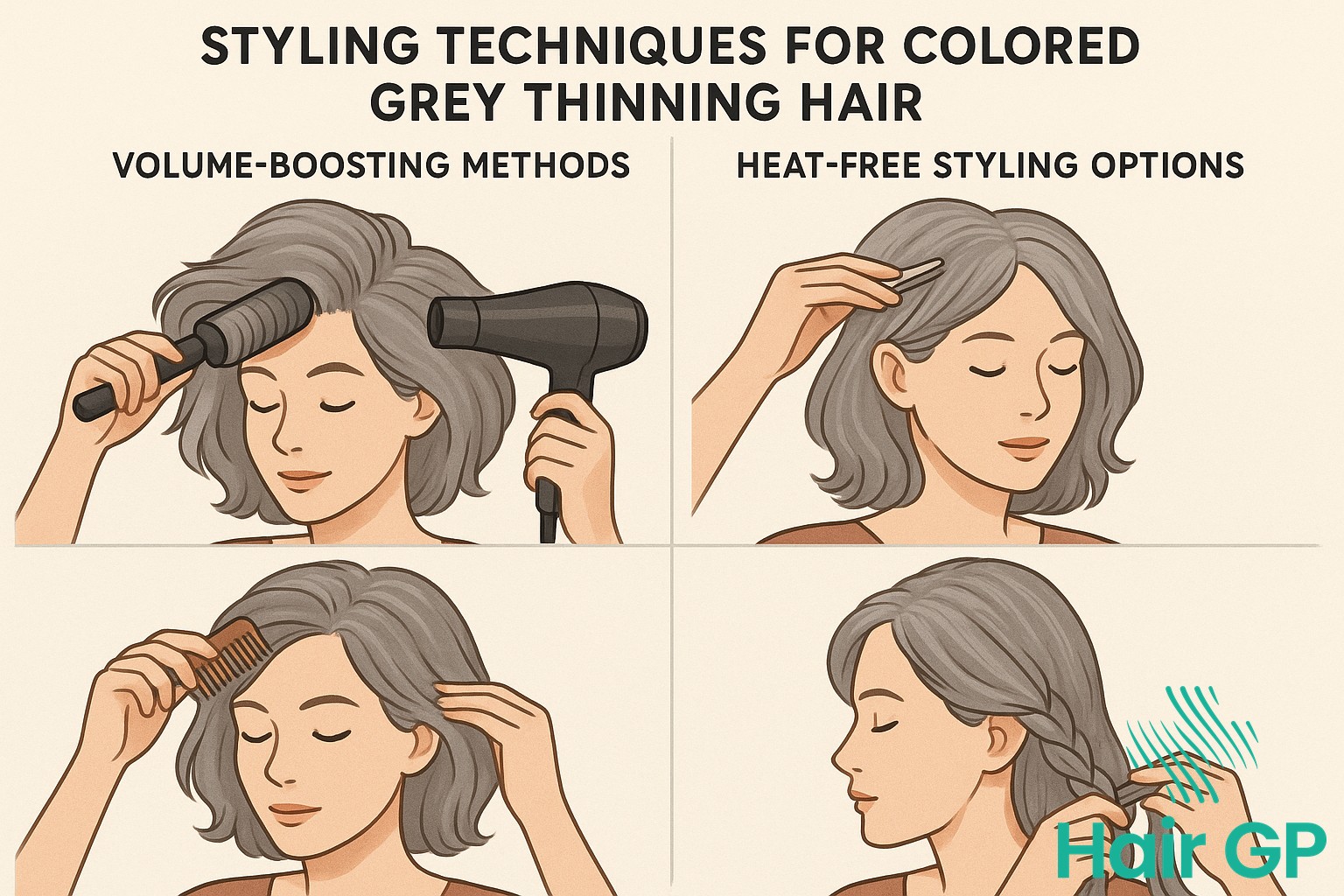
Common Mistakes That Damage Grey Thinning Hair
One of the most damaging mistakes involves using harsh permanent dye formulations specifically designed for younger, thicker hair. These aggressive chemicals can accelerate hair loss by weakening already fragile strands. Grey hair requires gentler formulations specifically created for mature hair textures. Semi-permanent or demi-permanent options provide color enhancement without the destructive effects of ammonia-based permanent dyes.
Color selection errors compound damage significantly. Attempting to cover grey with dark hair shades that contrast dramatically with natural lighter grey tones creates an unnatural appearance while requiring frequent touch-ups that stress hair follicles. Instead, choose colors within two shades of your natural grey base, gradually transitioning to desired tones through multiple gentle applications.
Mechanical damage from aggressive brushing, tight styling, and excessive heat styling particularly affects thinning hair. Wet hair becomes extremely vulnerable, yet many people brush soaked strands vigorously. Use wide-tooth combs on damp hair and limit heat styling to essential occasions. When heat styling is necessary, apply protective products and use lower temperature settings.
Overwashing represents another common error that strips natural oils essential for scalp health. Thinning hair benefits from washing every other day or less frequently, depending on oil production. Between washes, dry shampoo can refresh roots without disturbing delicate strands. Additionally, using heavy products specifically formulated for thick hair can weigh down fine strands, making hair loss appear more pronounced than it actually is.
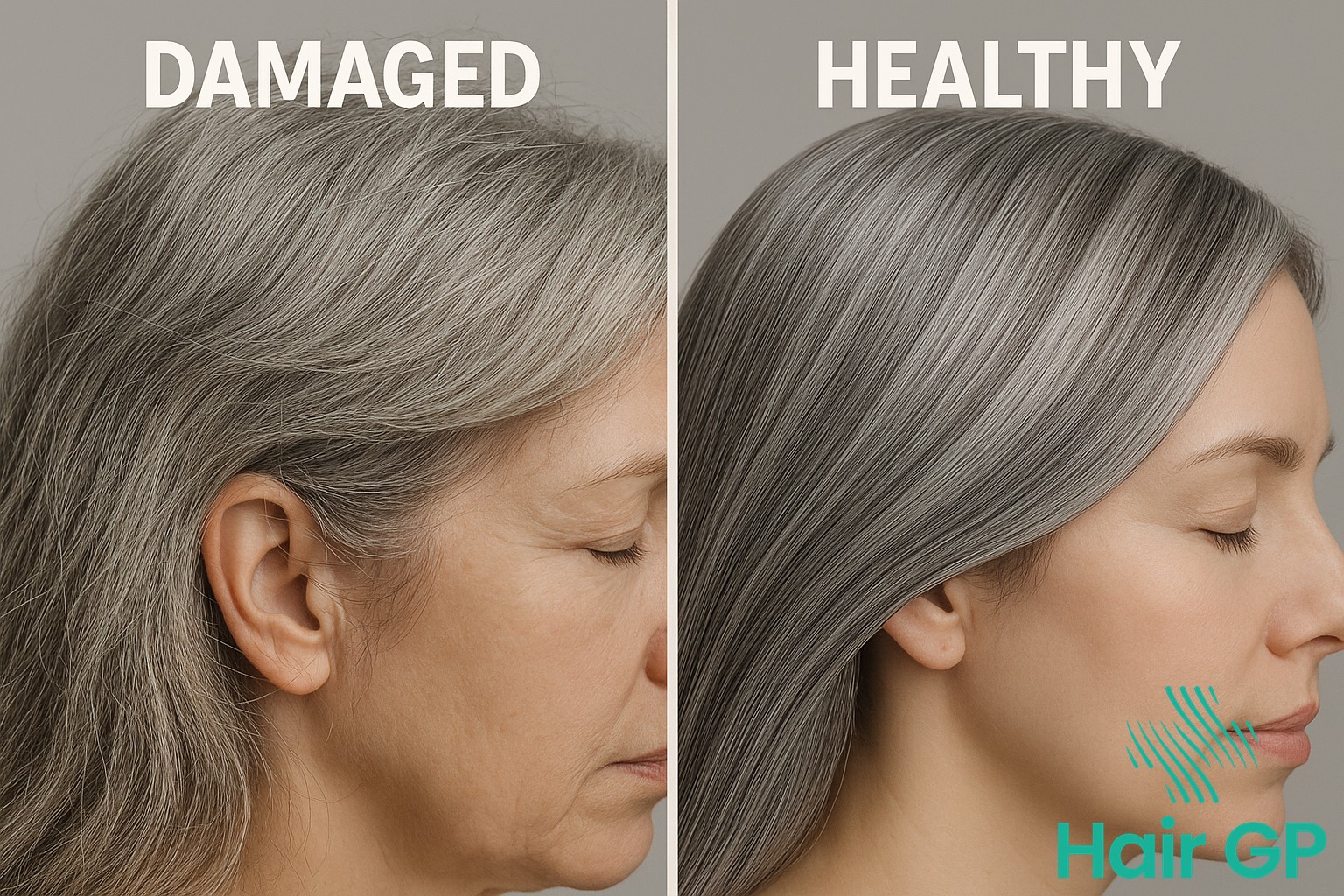
Conclusion
Achieving successful grey hair coverage with thin hair demands a thoughtful approach that prioritizes healthy hair above all else. The delicate nature of thinning strands requires gentle coloring techniques that minimize damage while delivering satisfactory results. Professional consultation ensures appropriate product selection and application methods tailored specifically to your hair’s unique needs and limitations.
Hair protection remains paramount throughout the coloring process and beyond. Investing in quality products designed for color-treated and thinning hair creates the foundation for lasting, beautiful results. Regular deep conditioning treatments, heat protection, and gentle handling preserve both hair color vibrancy and strand integrity over time.
Realistic expectations play a crucial role in satisfaction with grey coverage outcomes. Thin hair may require multiple sessions to achieve desired opacity, and frequent maintenance appointments become essential for sustained results. Understanding these inherent limitations prevents disappointment and promotes better decision-making throughout your coloring journey.
The path toward beautiful hair color with thinning hair requires patience, proper technique, and unwavering commitment to consistent care. By embracing gentle coloring methods and dedicating yourself to ongoing hair protection, you can achieve attractive grey hair coverage while maintaining the health and appearance of your precious strands. Ultimate success lies in thoughtfully balancing aesthetic goals with hair preservation priorities.
Frequently Asked Questions
Yes, but it requires extra caution. Choose gentler semi-permanent or demi-permanent colors, consider professional consultation, and always prioritize hair health over coverage. Deep conditioning treatments before and after coloring are essential.
For thinning grey hair, limit root touch-ups to every 6-8 weeks minimum. Focus only on new growth areas and use the gentlest formula possible. Consider temporary root concealer between colorings to extend time between applications.
Use ammonia-free, semi-permanent colors designed for grey coverage. Always perform a patch test as per the instructions on the product. Also always perform a strand test, deep condition beforehand, and follow timing instructions precisely. Avoid overlapping onto previously colored hair.
Traditional highlights require bleaching which can be too harsh for thin grey hair. Consider lowlights or subtle color variations using deposit-only formulas instead. Professional consultation is recommended for any lightening processes.

